
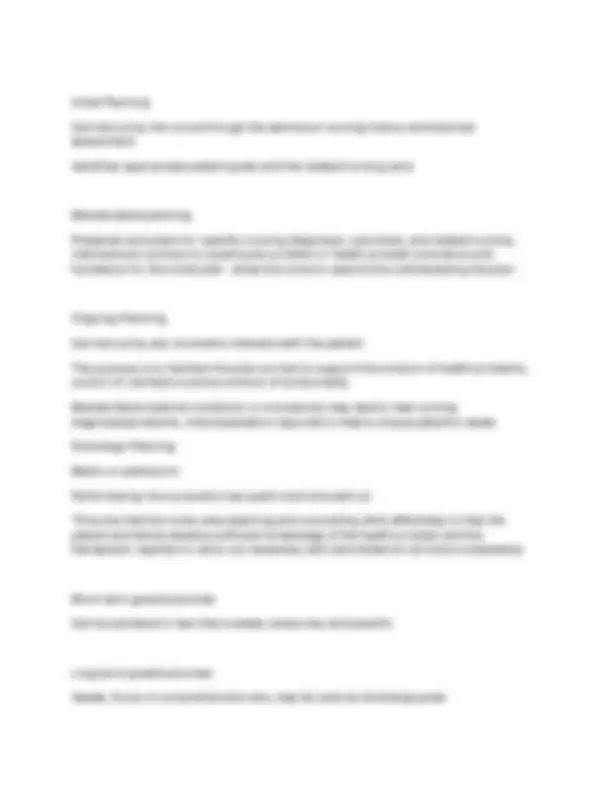
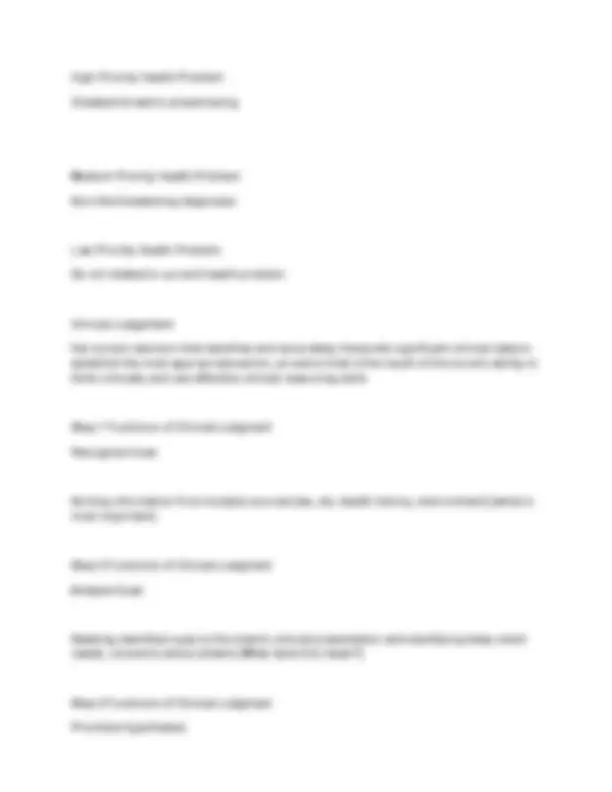
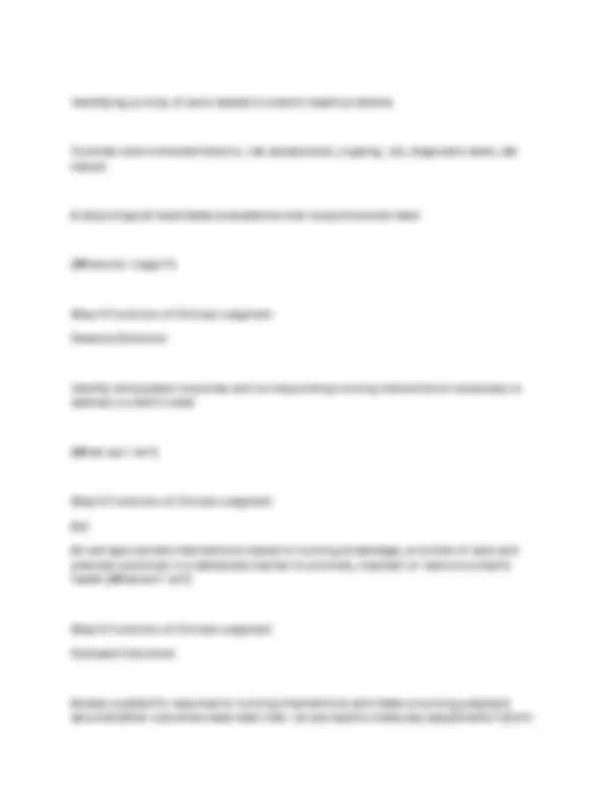
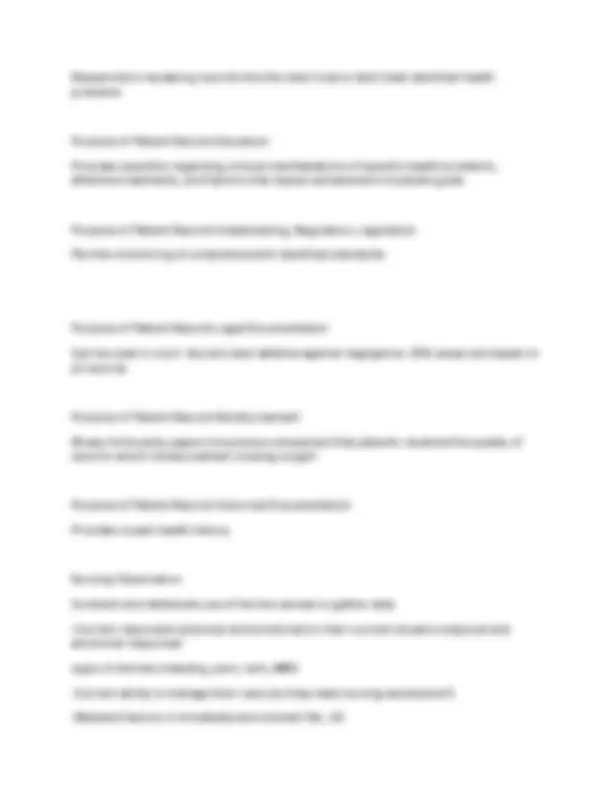
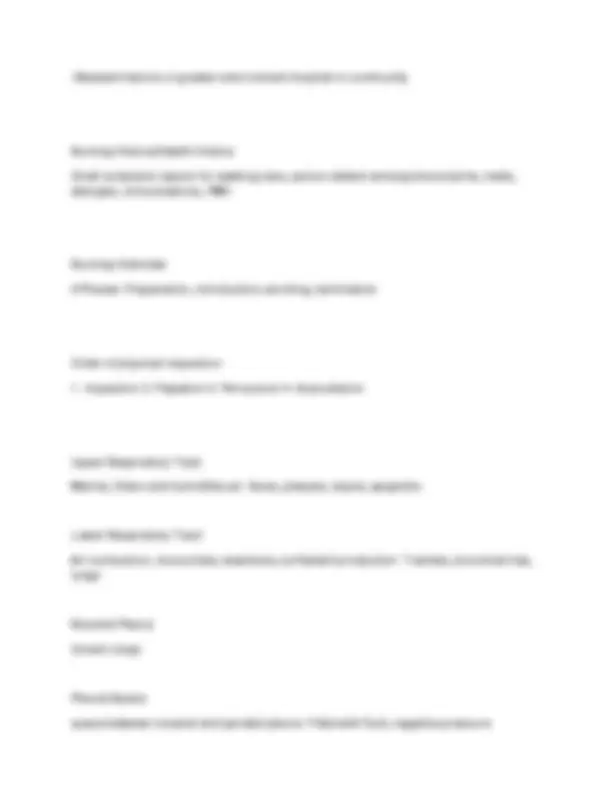
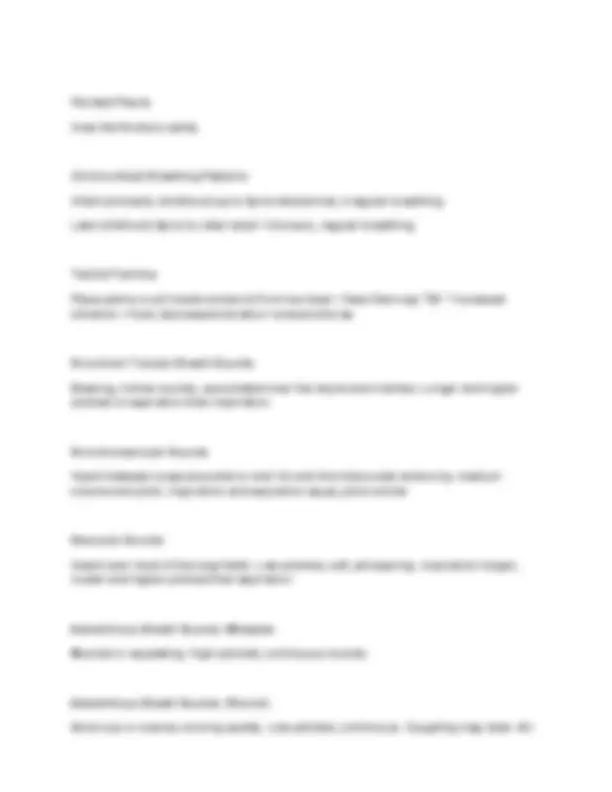
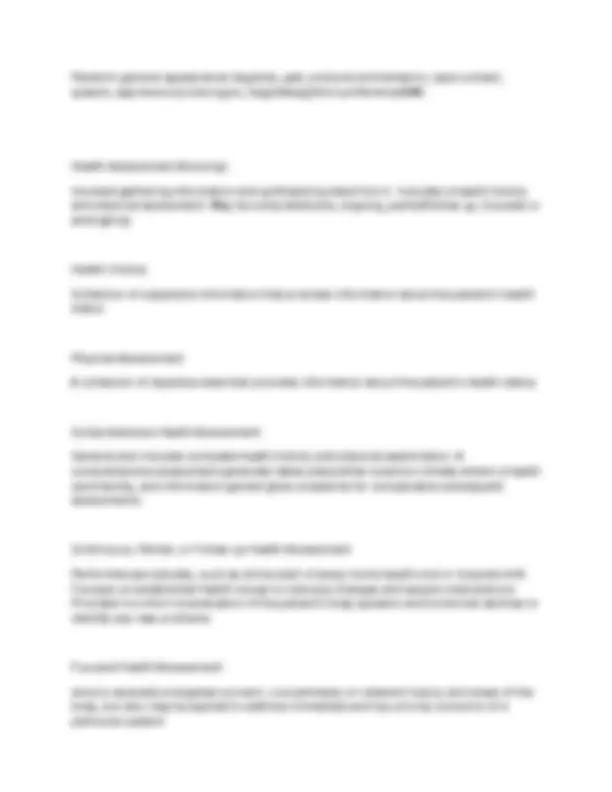
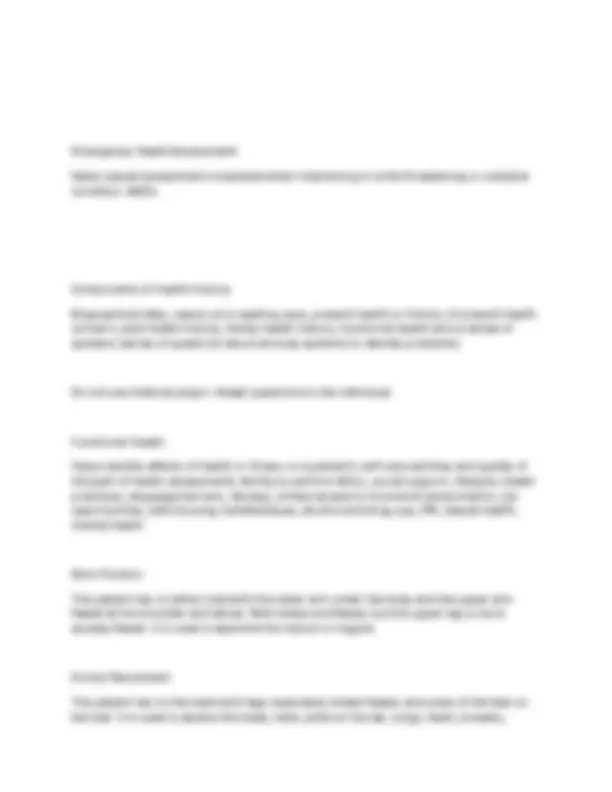
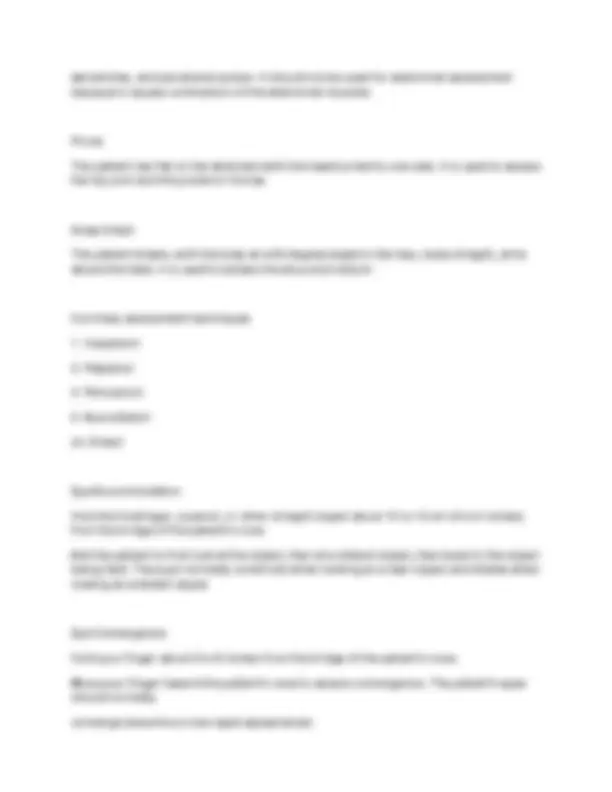
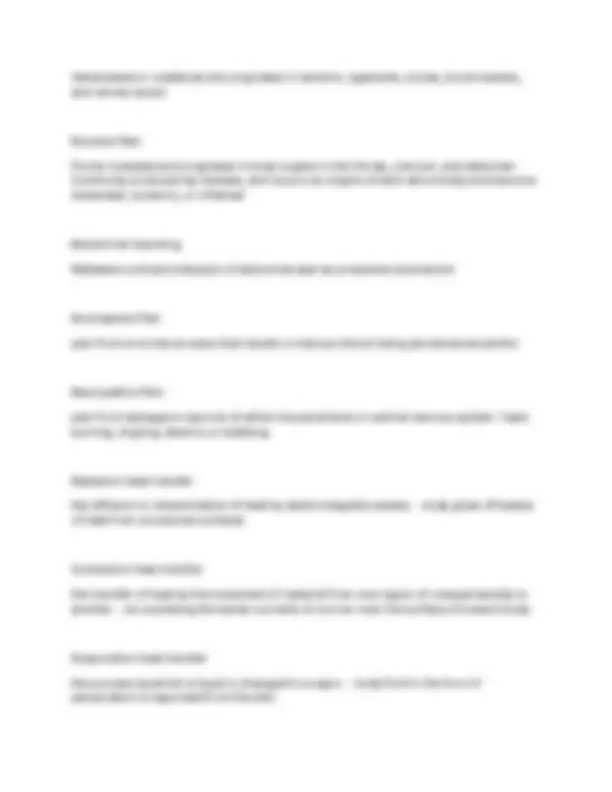
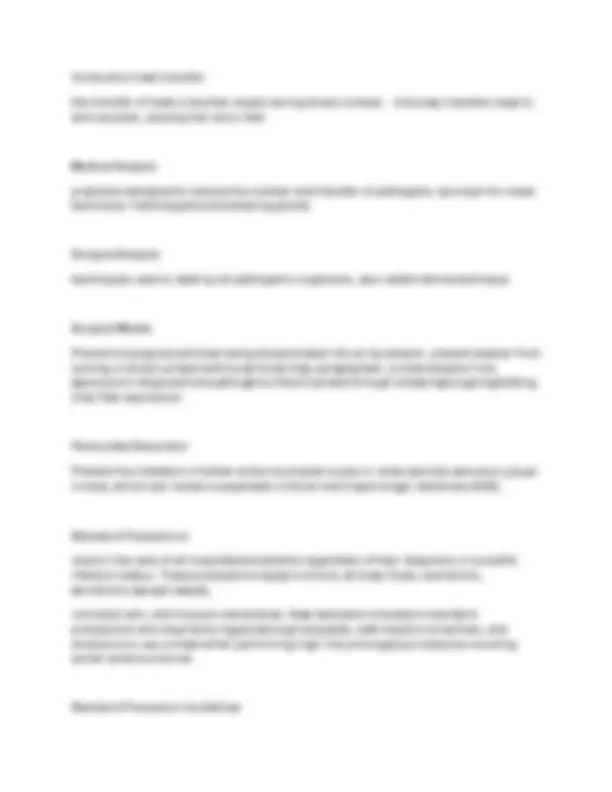
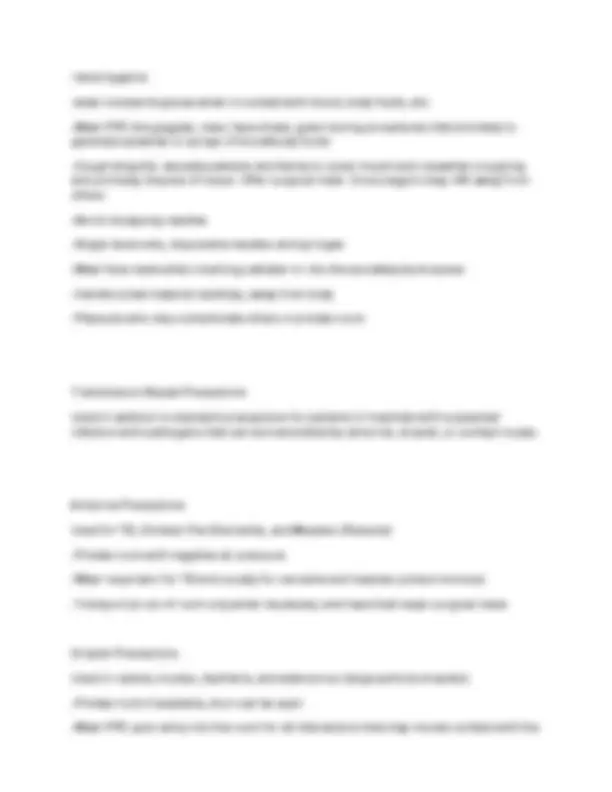
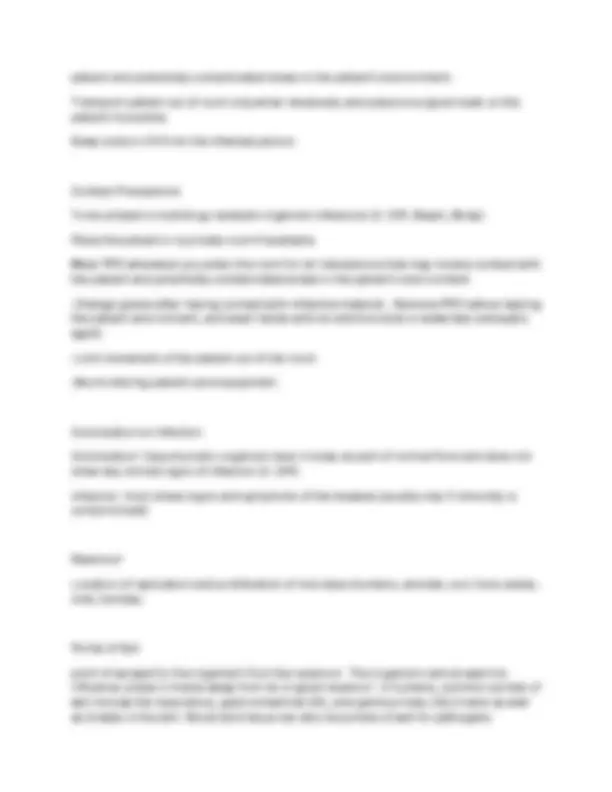
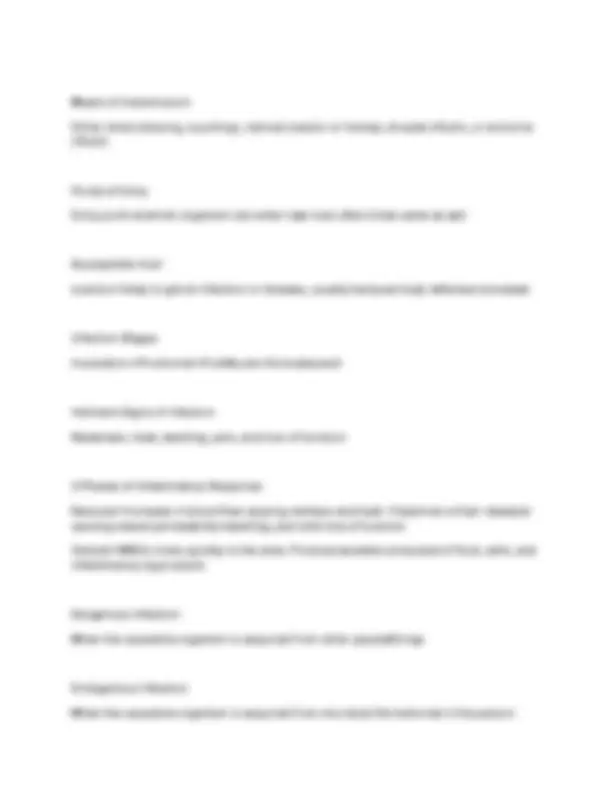

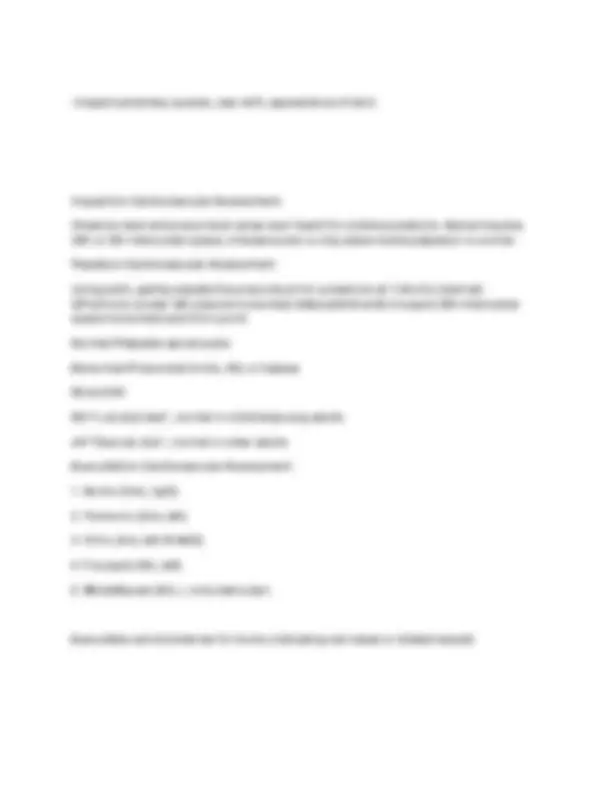
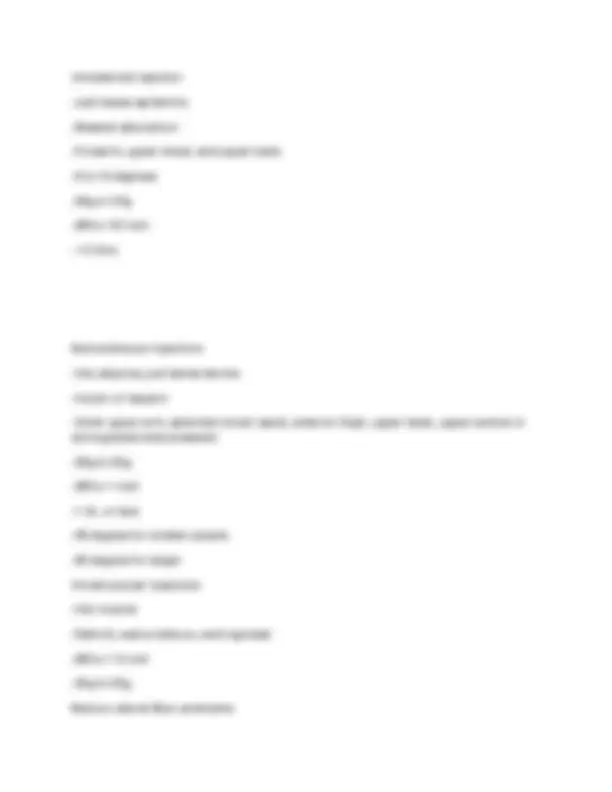
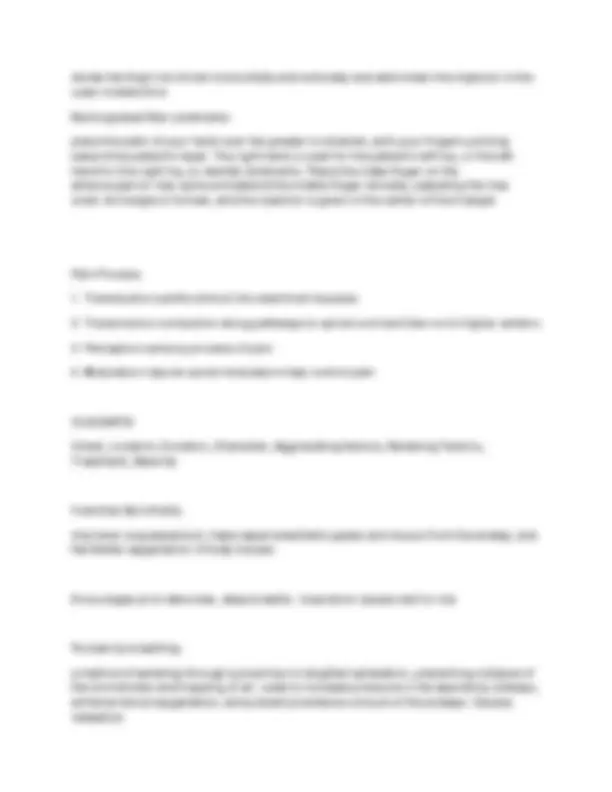
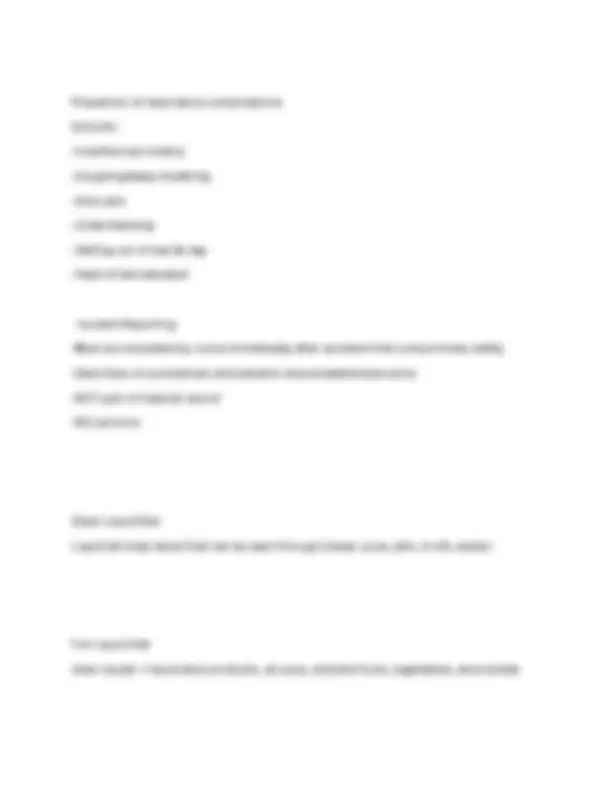
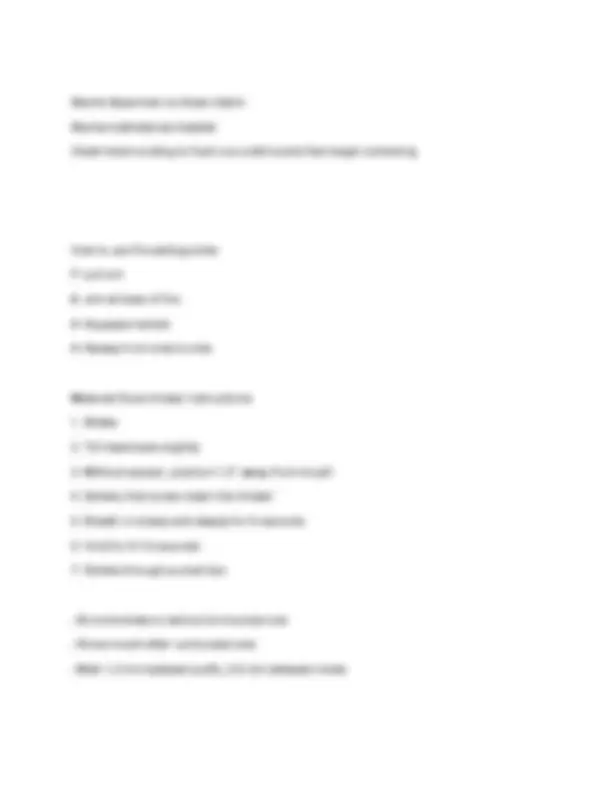


Study with the several resources on Docsity

Earn points by helping other students or get them with a premium plan


Prepare for your exams
Study with the several resources on Docsity

Earn points to download
Earn points by helping other students or get them with a premium plan
Community
Ask the community for help and clear up your study doubts
Discover the best universities in your country according to Docsity users
Free resources
Download our free guides on studying techniques, anxiety management strategies, and thesis advice from Docsity tutors
A comprehensive overview of the nursing process, including assessment, diagnosis, planning, implementation, and evaluation. It also covers the sbar communication technique, clinical judgment, and the hierarchy of needs. Particularly useful for nursing students who are learning about the fundamentals of nursing practice.
Typology: Exams
1 / 28

This page cannot be seen from the preview
Don't miss anything!





















Nursing Process Assessment, diagnosis, planning, implementation, evaluation
SBAR Situation, background, assessment, recommendation
Situation (SBAR) Identify self, unit, patient, and room number. Briefly state problem, when it happened, and severity.
Background (SBAR) Admitting dx, current meds/allergies, VS, labs, code status
Assessment (SBAR) Nurses assessment of situation
Recommendation (SBAR) Nurses recommendation (order change, see pt now, admittance notification)
Nursing diagnosis A clinical judgment concerning a human response to health conditions/life processes, or a judgment related to a human's vulnerability for that response. Nursing diagnosis provides the foundation for selecting nursing interventions to attain outcomes for which the nurse is accountable
Medical diagnoses describe problems for which the physician or advanced practice nurse directs the primary treatment. A medical diagnosis remains the same for as long as the disease is present, whereas patient problems may change daily as the patient's responses change
SMART goals Specific, measurable, attainable, realistic, time bound
Cognitive Outcome Describes an increase in patient's knowledge, intellectual behaviors
Psychomotor Outcome describes the patient's achievement of a new skill
Affective Outcome Describe the patient's changes in values, beliefs, and attitudes
Clinical Outcome Describes the expected status of health issues at specific points in time after treatment is complete; addresses whether or not problems have been resolved or to what degree they have improved
Functional Outcome Describes the person's ability to function with the desired usual activity
Quality-of-Life Outcome Focus on critical factors that affect someone's ability to enjoy life and achieve personal goals
High Priority Health Problem Greatest threat to pt well-being
Medium Priority Health Problem Non-life-threatening diagnoses
Low Priority Health Problem Dx not related to current health problem
Clinical Judgement the nurse's decision that identifies and accurately interprets significant clinical data to establish the most appropriate action, an action that is the result of the nurse's ability to think critically and use effective clinical reasoning skills
Step 1 Functions of Clinical Judgment Recognize Cues
Sorting information from multiple sources [ex, s/s, health history, environment] [what is most important]
Step 2 Functions of Clinical Judgment Analyze Cues
Relating identified cues to the client's clinical presentation and identifying likely client needs, concerns and problems [What does this mean?]
Step 3 Functions of Clinical Judgment Prioritize Hypotheses
Identifying priority of care related to client's health problems
Consider environmental factors, risk assessment, urgency, s/s, diagnostic tests, lab values
A physiological need takes precedence over a psychosocial need
[Where do I begin?]
Step 4 Functions of Clinical Judgment Develop Solutions
Identify anticipated outcomes and corresponding nursing interventions necessary to address a client's need
[What can I do?]
Step 5 Functions of Clinical Judgment Act An act appropriate interventions based on nursing knowledge, priorities of care and planned outcomes in a deliberate manner to promote, maintain or restore a client's health [What will I do?]
Step 6 Functions of Clinical Judgment Evaluate Outcomes
Assess a patient's response to nursing interventions and make a nursing judgment about whether outcomes have been met — do we need to make any adjustments? [Did it
PHI Breech-Computer Make sure display screens do not face public areas. For portable devices install encryption software
PHI Breech-Email on public network Encryption software
PHI Breech-Voice Pager Limit voice messages to nonconfidential messages only
Purpose of Patient Record-Communication Most valuable! Provides continuity of care amongst providers from different facet of care team
Purpose of Patient Record-Diagnostic + Therapeutic Orders Studies, results orders etc. all in ONE PLACE
Purpose of Patient Record-Care Planning Able to change current plan of care as pt's ongoing data is compared to data baseline
Purpose of Patient Record-Quality Process/Performance Improvement Identifies for accrediting organizations if nurses are meeting identified standards of care through a review of patient outcomes
Purpose of Patient Record-Research
Researchers reviewing records like this learn how to best treat identified health problems
Purpose of Patient Record-Education Provides specifics regarding clinical manifestations of specific health problems, effective treatments, and factors that impact achievement of patient goals
Purpose of Patient Record-Credentialing, Regulation, Legislation Permits monitoring of compliance with identified standards
Purpose of Patient Record-Legal Documentation Can be used in court. Nurse's best defense against negligence. 25% cases are based on pt records
Purpose of Patient Record-Reimbursement Shows third-party payers (insurance companies) that patients received the quality of care for which reimbursement is being sought
Purpose of Patient Record-Historical Documentation Provides a past-health history
Nursing Observation Constant and deliberate use of the five senses to gather data. -Current responses (physical and emotional) to their current situation physical and emotional responses signs of distress bleeding, pain, rash, AMS -Current ability to manage their care (do they need nursing assistance?) -Relevant factors in immediate environment IVs, O
Parietal Pleura lines the thoracic cavity
Child vs Adult Breathing Patterns Infant and early childhood (up to 5yrs)=abdominal, irregular breathing Late childhood (6yrs) to older adult = thoracic, regular breathing
Tactile Fremitus Place palms on pt's back and work from top down. Have them say "99." Increased vibration = fluid, decreased vibration =pneumothorax
Bronchial / Tubular Breath Sounds Blowing, hollow sounds, auscultated over the larynx and trachea. Longer and higher pitched on expiration than inspiration
Bronchovesicular Sounds Heard between scapula posterior and 1st and 2nd intercostal anteriorly; medium volume and pitch; inspiration and expiration equal, pitch similar
Vesicular Sounds Heard over most of the lung fields. Low-pitched, soft, whispering. Inspiration longer, louder and higher pitched then expiration
Adventitious Breath Sounds: Wheezes Musical or squeaking. High-pitched, continuous sounds.
Adventitious Breath Sounds: Rhonchi Sonorous or coarse; snoring quality. Low-pitched, continuous. Coughing may clear. Air
passing through secretions
Adventitious Breath Sounds: Crackles Bubbling, crackling, popping. Low- to high- pitched, discontinuous sounds. Opening of deflated small airways and alveoli; air passing through fluid in the airwats
Adventitious Breath Sounds: Stridor Hoarse, loud, high-pitched. Auscultated on inspiration. Narrowing of upper airway; presence of foreign body in airway
Adventitious Breath Sounds: Friction Rub Friction, grating. Loudest over lower lateral anterior surface. Inflamed pleura rubbing against chest wall
Nasal Cannula-Low Flow 1-2lpm = 24-28% 3-5lpm = 32-40% 5lpm = 44%
COPD spO2 desirable level Minimum needed to raise ARTERIAL O2 saturation to maintain 88-92%
Nasal Cannula-High Flow 10lpm = 65% 15lpm = 90%
Max flow 60lpm. Tolerated better by children than other non-invasive methods.
Patient's general appearance (hygiene, gait, posture) and behavior, (eye contact, speech, expressions) vital signs, height/weight/circumference/BMI.
Health Assessment (Nursing) Involved gathering information and synthesizing data from it. Includes a health history and physical assessment. May be comprehensive, ongoing, partial/follow-up, focused or emergency
Health History Collection of subjective information that provides information about the patient's health status
Physical Assessment A collection of objective date that provides information about the patient's health status
Comprehensive Health Assessment General and includes complete health history and physical examination. A comprehensive assessment generally takes place when a person initially enters a health care facility, and information gained gives a baseline for comparative subsequent assessments.
Continuous, Partial, or Follow-up Health Assessment Performed periodically, such as at the start of every home health visit or hospital shift Focuses on established health issues to note any changes and assess interventions Provided is a short re-evaluation of the patient's body systems and functional abilities to identify any new problems
Focused Health Assessment done to evaluate a targeted concern; concentrates on relevant history and areas of the body, but also may be applied to address immediate and top priority concerns of a particular patient
Emergency Health Assessment faster paced assessment completed when intervening in a life-threatening or unstable condition. ABCs
Components of Health History Biographical data, reason pt is seeking care, present health or history of present health concern, past health history, family health history, functional health and a review of systems (series of questions about all body systems to identify problems).
Do not use medical jargon. Adapt questions to the individual.
Functional Health Helps identify effects of health or illness on a patient's self-care abilities and quality of life (part of health assessment); Ability to perform ADLs, social support, lifestyle, health practices, language barriers, literacy, limited access to food and transportation, job opportunities, safe housing, beliefs/values, alcohol and drug use, IPV, sexual health, mental health
Sims Position The patient lies on either side with the lower arm under the body and the upper arm flexed at the shoulder and elbow. Both knees are flexed, but the upper leg is more acutely flexed. It is used to examine the rectum or vagina.
Dorsal Recumbent The patient lies on the back with legs separated, knees flexed, and soles of the feet on the bed. It is used to assess the head, neck, anterior thorax, lungs, heart, breasts,
Pulse Deficit difference between apical and radial rate
Tachypnea vs Hyperventilation Tachypnea fast (>24bpm) ans shallow. Hyperventilation fast and deep
Cheyne-Stokes respiration Alternating periods of deep, rapid breathing followed by periods of apnea, regular. Indicates drug overdose, increased ICP, or heart failure
Hypoventilation vs Bradypnea Bradypnea = <10bpm; regular. Hypoventilation = decreased rate and depth; irregular
Pulse Pressure difference between systolic and diastolic pressure
Hypertension Stage 1 130-139 systolic or 80-89 diastolic
Hypertension Stage 2
140 systolic OR >90 diastolic
Hypertensive Crisis
180 systolic and/or >120 diastolic
Blood Pressure Common Errors Fit: Should be pulled taut when placed on bare limb, with equal tightness at top and bottom. One finger should fitr easilt at the top/bottom; two fingers should fit but be snug. Incorrect cuff size is most common error. Too tight/small=erroneously high Too wide/big = erroneously low
Popliteal Blood Pressure Systolic up to 40mmHg higher, diastolic same. Ideally have pt lay prone. If unable, supine with knees slighty flexed. Use specific BP cuff or one that is large enough. Place cuff around the lower third of thigh, centered over and 2.5cm above popliteal artery
Acute Pain generally rapid in onset and varies in intensity from mild to severe. It is protective in nature. In other words, acute pain warns the person of tissue damage or organic disease and provokes autonomic responses such as tachycardia, the fight-or-flight response, and increased blood pressure. Once its underlying cause is resolved, acute pain disappears.
Chronic Pain maladaptive pain that persists or is recurrent for more than 3 months
Cutaneous Pain superficial pain usually involving the skin or subcutaneous tissue papercut
Somatic Pain
Conduction heat transfer the transfer of heat to another object during direct contact. - the body transfers heat to and ice pack, causing the ice to melt
Medical Asepsis practices designed to reduce the number and transfer of pathogens; synonym for clean technique. Hand hygiene and wearing gloves
Surgical Asepsis techniques used to destroy all pathogenic organisms, also called sterile technique
Surgical Masks Prevent biopogical particles being disseminated into air by wearer; prevent wearer from coming in direct contact with body fluids they spray/splash; protect wearer from exposure to large particle pathogens (>5um) spread through sneezing/coughing/talking. Only filter expired air
Particulate Respirator Prevent the inhalation of either airborne droplet nuclei or small particle aerosols (≤ 5 μm in size), which can remain suspended in the air and travel longer distances (N95)
Standard Precautions Used in the care of all hospitalized patients regardless of their diagnosis or possible infection status. These precautions apply to blood, all body fluids, secretions, excretions (except sweat), nonintact skin, and mucous membranes. New elements included in standard precautions are respiratory hygiene/cough etiquette, safe injection practices, and directions to use a mask when performing high-risk prolonged procedures involving spinal canal punctures
Standard Precaution Guidelines
-hand hygeine -wear nonsterile gloves when in contact with blood, body fluids, etc. -Wear PPE like goggles, masl, face shield, gown during procedures that are likely to generate splashes or sprays of blood/body fluids -Cough etiquitte: educate patients and family to cover mouth and nosewhen coughing and promptly dispose of tissue. Offer surgical mask. Encourage to stay >3ft away from others -Avoid recapping needles -Single dose vials, disposable needles and syringes -Wear face mask when inserting catheter or into the spinal/epidural space -Handle soiled material carefully, away from body -Place pts who mau contaminate others in private room
Transmission Based Precautions Used in addition to standard precautions for patients in hospitals with suspected infection with pathogens that can be transmitted by airborne, droplet, or contact routes.
Airborne Precautions Used for TB, Chicken Pox (Varicella), and Measles (Rubeola) -Private room with negative air pressure -Wear respirator for TB and usually for varicella and measles (unless immune) -Transport pt out of room only when necessary and have them wear surgical mask
Droplet Precautions Used in rubella, mumps, diptheria, and adenovirus (large particle droplets) -Private room if available, door can be open -Wear PPE upon entry into the room for all interactions that may involve contact with the